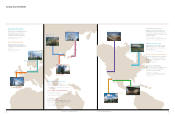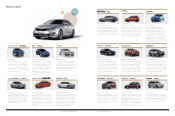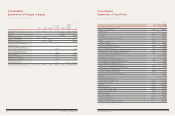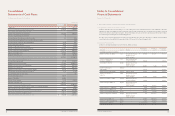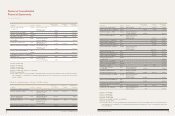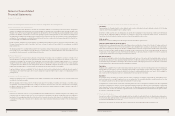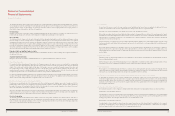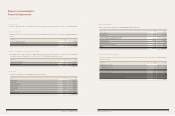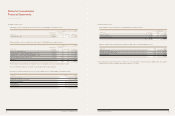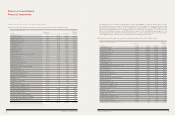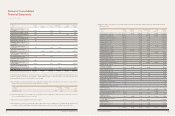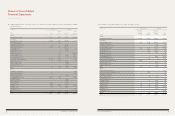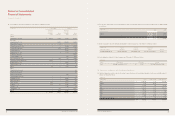Kia 2010 Annual Report Download - page 33
Download and view the complete annual report
Please find page 33 of the 2010 Kia annual report below. You can navigate through the pages in the report by either clicking on the pages listed below, or by using the keyword search tool below to find specific information within the annual report.
(ii) Other Intangible Assets
Other intangible assets, which consist of rights of trademark, patent rights and facility usage right, are amortized using the straight-line
method over the following periods.
Through March 1999, under the National Pension Scheme of Korea, the Company transferred a certain portion of retirement allowances for
employees to the National Pension Fund. The amount transferred will reduce the retirement and severance benefit amount to be payable
to the employees when they leave the Company and is accordingly reflected in the accompanying consolidated statements of financial
position as a reduction of the retirement and severance benefits liability. However, due to the new regulation effective April 1999, such
transfers to the National Pension Fund are no longer required.
In addition, employees of Kia Motors America, Inc. is eligible to participate, upon meeting certain service requirement, in the profit sharing
retirement plan under the Internal Revenue Code 401(k) in the United States and defined benefit pension plan.
(o) Valuation of Receivables and Payables at Present Value
Receivables and payables arising from long-term loans/borrowings and other similar transactions are stated at present value. The difference
between the nominal value and the present value of such receivables or payables is amortized using the effective interest method as noted
below. The amount amortized is included in interest expense or interest income.
(p) Foreign Currency Translation
Monetary assets and liabilities denominated in foreign currencies are translated into Korean won at the foreign exchange rate at the
end of the reporting period, with the resulting gains or losses recognized in the results of operations. Non-monetary assets and liabilities
denominated in foreign currencies, which are stated at historical cost, are translated into Korean won at the foreign exchange rate on the
date of the transaction.
Foreign currency assets and liabilities of foreign-based operations and companies accounted for using the equity method are translated
at the rate of exchange at the end of the reporting period. Foreign currency amounts in the statement of income are translated using an
average rate and foreign currency balances in the capital account are translated using the historical rate. Translation gains and losses arising
from collective translation of the foreign currency financial statements of foreign-based operations are recorded net as accumulated other
comprehensive income. These gains and losses are subsequently recognized as income in the year the foreign operations or the companies
are liquidated or sold.
(q) Derivatives and Hedge Accounting
The Company holds derivative financial instruments to hedge its foreign currency and interest rate risk exposures. Embedded derivatives
are separated from the host contract and accounted for separately if the economic characteristics and risks of the host contract and the
embedded derivative are not closely related, and a separate instrument with the same terms as the embedded derivative would meet the
definition of a derivative.
Derivatives are initially recognized at fair value on the date a derivative contract is entered into and are subsequently remeasured at their fair
value. Attributable transaction costs are recognized in profit or loss when incurred.
Hedge accounting
Where a derivative, which meets certain criteria, is used for hedging the exposure to changes in the fair value of a recognized asset, liability
or firm commitment, it is designated as a fair value hedge. Where a derivative, which meets certain criteria, is used for hedging the
exposure to the variability of the future cash flows of a forecasted transaction it is designated as a cash flow hedge.
Notes to Consolidated
Financial Statements
December 31, 2010 and 2009
Useful lives (years)
Rights of trademark 5
Patent rights 10
Facility usage right 10
(k) Government Grant Received for Capital Expenditure
Government grant received from third parties for capital expenditure are presented as a reduction of the acquisition cost of the acquired
assets and, accordingly, reduce depreciation expense related to the acquired assets over their useful lives.
Income from grants that do not require the Company to fulfill any subsequent obligations and is directly related to the Company’s operating
activities is recognized as operating income, net of related costs. Other income from grants is recognized as other income.
(l) Bonds with Warrants
When accounting for bonds with stock purchase warrants, the liability component and the equity component of a bond are separated.
The liability component of a bond is recognized initially at fair value. Fair value is the present value of a similar debt security that does not
have stock purchase warrants. The equity component is recognized initially as the difference between the fair value of the bond as a whole,
which are the gross proceeds of the bond received at the date of issuance, and the fair value of the liability component. In the case of
bonds with detachable stock warrants, the fair values of the liability and equity components are calculated separately. The equity
component of bonds with stock purchase warrants are presented as part of capital surplus within equity.
Subsequent to initial recognition, the liability component is measured at amortized cost using the effective interest rate method. The equity
component is not remeasured subsequent to initial recognition.
(m) Discount (Premium) on Debentures
Discount (premium) on debentures issued, which represents the difference between the face value and issuance price of debentures, is
amortized (accreted) using the effective interest method over the life of the debentures. The amount amortized (accreted) is included in
interest expense.
(n) Retirement and Severance Benefits
Employees who have been with the Company for more than one year are entitled to lump-sum payments based on salary rates and length
of service at the time they leave the Company. The Company’s estimated liability under the plan which would be payable if all employees
left at the end of the reporting period, is accrued in the accompanying consolidated statements of financial position. A portion of the liability
is covered by an employees’ severance benefits trust where the employees have a vested interest in the deposit with the insurance
company in trust. The deposit for severance benefits held in trust is, therefore, reflected in the accompanying consolidated statements of
financial position as a reduction of the liability for retirement and severance benefits.
Account Interest rate(%) Period
Long-term accounts receivable – trade* 7.95~8.75 From one to five years
Long-term accounts receivable - other 4.15 From one to three years
*Current portion of long-term accounts receivable is included in current accounts and notes receivable - trade at present value.
probable future economic benefit; (4) the Company has adequate technical, financial and other resources to complete the development
of the intangible asset and the intangible asset will be available; and (5) the expenditures attributable to the intangible asset during its
development can be reliably determined.
If the costs incurred fail to satisfy these criteria, they are recorded as expenses as incurred. Where development costs satisfy the criteria,
they are capitalized and amortized on a straight-line basis over the economic useful life of the related assets. The expenditure capitalized
includes the cost of materials, direct labor and an appropriate proportion of overheads.
66 COMPONENTS OF SUSTAINABLE GROWTH 67
KIA MOTORS ANNUAL REPORT 2010


